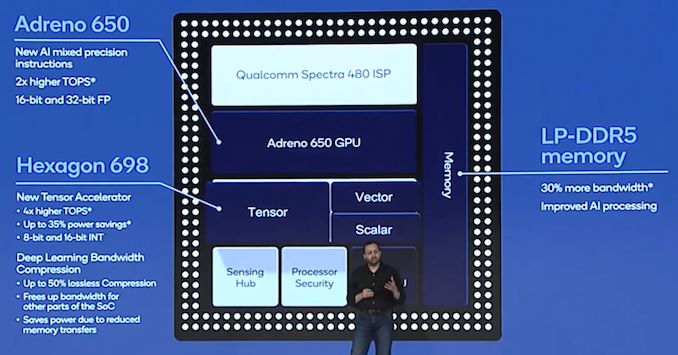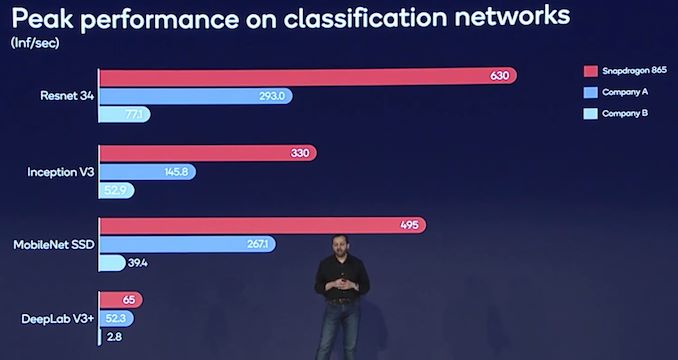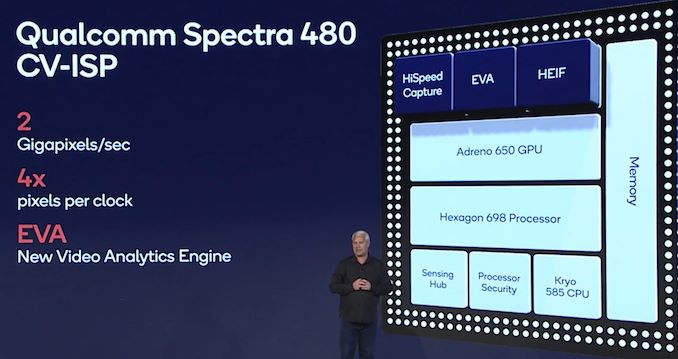Qualcomm Announces Snapdragon 865 and 765(G): 5G For All in 2020, All The Details
by Andrei Frumusanu on December 4, 2019 1:50 PM EST- Posted in
- Mobile
- Qualcomm
- Smartphones
- SoCs
- 7nm
- 5G
- Snapdragon 865
- Snapdragon 765
Immense AI, Camera and ISP Upgrades
New Hexagon 695 DSP: 4x Performance On New Tensor Cores - 15 TOPs Total on SoC
The Snapdragon 865 now ships with the new Hexagon 695 DSP block. The single biggest improvement of the new design is a massive quadrupling of the processing power of the dedicated tensor cores. This jump alone is able to double the SoC’s aggregate AI processing ability up from 7 TOPs to 15 TOPs.
Qualcomm here still doesn’t properly do a breakdown between the IP blocks which contribute to this number, but given that the GPU only saw a ~20% increase, and that the Hexagon’s scalar and vector execution units this year have remained the same in terms of performance, we estimate that the tensor units now roughly come in at around 10TOPs by themselves.
Qualcomm has also now included lossless weight and activation compression for the Tensor cores, being able to reduce bandwidth consumption up to 50%. This is a similar feature we've seen advertised by third-party NPU IP offerings, only that Qualcomm is going to be shipping this now in a product in just a few months.
Power efficiency of the block is also have said to have improved by 35%, making computations less costly in terms of battery life.
Qualcomm talks how about its inference performance and inference power efficiency is significantly higher than competing solutions. We don't know the comparison SoCs being showcased here, but a likely candidates here are the Apple A13 and the Kirin 990? It could also be an Exynos or other SoC.
New Spectra CV-480 ISP: 2 Gigapixels/s Enabling Massive Sensors
Aside from its 5G abilities, it’s very much evident that camera is very much at the very centre of the Snapdragon 865’s new features. The whole camera subsystem has seen some massive upgrades in the IP, and amongst the biggest improvements in capability lies in the new Spectra 480 computer-vision ISP.
The new IP has seen a major architectural change in that it’s now able to process 4 pixels per clock instead of just only 1 PPC as in the previous generation. This has now massively upgraded the pixel processing throughput to 2 Gigapixels/second, allowing the SoC a wide variety of use-cases that in the past simply weren’t possible due to lack of raw power.
Starting off with video capture, the new SoC is able to now record in 4K HDR while simultaneously capturing up to 64MP still shots at the same time. But 4K video isn’t the limit anymore – and you even can say that in terms of framerate as now 4K120 recording is supported, but the Snapdragon 865 now supports 8K30 video recording.
Video recording quality continues to support all the features we’ve seen in the previous generation, meaning 10-bit and various HDR standards such as HLG, HDR10, HDR10+, but now the new SoC expands this even further with the introduction of the ability to do live recording in the Dolby Vision HDR standard. Qualcomm explains that the Snapdragon 865 not only is the first smartphone SoC to be able to do this, but it’s the first camera platform of any kind in the world, as usual Dolby Vision content right now is enabled post-capture in the editing room, rather being something that’s being natively recorded by a camera.
The new improved capabilities of the ISP and video encoder also erase some current recording limitations, for example, slow-motion video recording at 960fps is sustained indefinitely instead of being limited to a couple of seconds of real-time footage.
Although normally I wouldn’t have brought this up, MediaTek’s recent release of the Dimensity 1000 did recently popularise the discussion topic: No, the Snapdragon 865 doesn’t support the AV1 codec for video decoding. It looks like we’ll have to wait for the next generation for that.
In terms of still capture photography, the new ISP performance will now allow for support for sensors of up to 200MP, which actually don’t yet exist as Samsung’s recent 108MP behemoth is currently the largest of its class right now.
The new ISP now has various new functionalities in order to improve noise reduction and contrast enhancements. Particularly the new noise reduction features is said to be quite difficult to achieve.
Although Qualcomm advertises the 200MP figure predominantly, it’s to be noted that actual capture with zero shutter lag (ZSL) is limited to 64MP – so there is a rather larger compromise in capturing at resolutions beyond 64MP.
High Refresh Rate Displays Normalised: Support For 144Hz
Already some vendors are leading the pack in 2019, but we’re expecting 2020 to see wide-range adoption of high refresh-rate displays. Even more importantly, we’ll be seeing implementations at high resolutions higher than 90 and 120Hz, supporting up to 144Hz displays. Qualcomm explains that the barrier that’s been lifted here is the SoC’s Display Processing Unit (DPU) that has had its throughput significantly increased.
I asked the company about the impact on battery life and which component of a phone accounts for the highest power increases. Surprisingly, it’s not any one component, with most of them seeing pretty much just an evenly distributed linear increase in power requirements, with the actual display panel itself (excluding the DDIC), seeing actually the least increases in power draw.















91 Comments
View All Comments
name99 - Wednesday, December 4, 2019 - link
Andrei, something I asked last year, but never got an answer --- maybe this year QC will tell us:- is the fast core actually different from the slow cores in that it's using faster transistors? Or could the slow cores equally well be clocked at 2.84GHz if QC policy allowed it?
Or to put it differently, what's the energy excess for solving a problem at 2.84GHz rather than at 2.42? Is the slope so steep that running more than one core that fast was utterly infeasible?
(Point is, if it's the same transistors, so all cores could clock to 2.84, then it's usual quadratic overhead. But if the 2.84 circuits use HP rather than HE/HD transistors, the energy excess could be quite a bit higher.)
Kabm - Wednesday, December 4, 2019 - link
In the past QC give the one fast core more cache too. Energy aside, if they use all fast cores and a core failed that speed then the whole soc is failed, more cost overallRaqia - Wednesday, December 4, 2019 - link
The transistors used on the prime core have a larger pitch and use more fins:https://fuse.wikichip.org/news/2408/tsmc-7nm-hd-an...
name99 - Thursday, December 5, 2019 - link
Thanks! Great link.Andrei Frumusanu - Thursday, December 5, 2019 - link
It's a physically different core.Dragonstongue - Wednesday, December 4, 2019 - link
I still not quite understand why they have not really bothered to have true LOW - Mid - HIGH speed for the whole bunch of cores, I imagine would not be "that hard" would keep power use in check big time as well (save battery life, as pretty much all phone makers these days only want to sell a SEALED phone..let them play their game, let us enjoy what we have as long as possible)example
top core at whatever Ghz range, the mid cores at 1/2 to 1/3 less than this, the low cores (have maybe more of) but 1/2 the mid speed
so (again example)
1 @ 2.84Ghz
3 @ 1.42 or 1.89
4 @ 710Mhz or 945Mhz
I am quite certain with the "tweaking" they do and have done (for a number of years now)
even at say 500Mhz on 4 cores, it will still be able to handle many many things "just fine" provided they work their magic so it feeds and is fed by the memory and/or graphics properly
heck, they might even be able to use the good chunk extra power drop to clock the graphics up so even though it ends up using LESS power (stays very cool as well) still feels snappy as lightning
We have the technology, why not use it far more "intelligently" I ask?
peevee - Friday, December 6, 2019 - link
"We have the technology, why not use it far more "intelligently" I ask?"Total MT performance IN TESTS of your 1+3+4 configuration would be significantly lower than current 1+3+4 configuration, and review sites still insist on publishing irrelevant numbers.
The best configuration would probably be 1 superfast+16 superefficient.
Kabm - Wednesday, December 4, 2019 - link
Quote: "We also expect some compromises in terms of battery efficiency due to the silicon overhead, however as a counter-argument, Apple’s iPhones always have had separate AP+modem solutions, and the latest generation this year had amongst the strongest battery life performance of any device out there, even with a competing Intel modem."No you tested iPhone on wifi without 4G usage so cannot say it had strong battery life in 4G or 5G.
yacoub35 - Thursday, December 5, 2019 - link
>Qualcomm says this would be possible if you essentially just ignore the X55’s 5G capabilities, but they don’t see any reason for any vendor to actually do this. In essence, bar any abnormal decision from some vendors, all Snapdragon 865 devices in 2020 will be full 5G devices.I'll definitely take the one without the cellular equivalent of a cancer stick embedded in it (5G).
peevee - Friday, December 6, 2019 - link
There is a non-zero probability that mmWave in phones will be prohibited in 10 years. Not that anybody would really miss it as it does not work in real-life situations anyway (does not even penetrate your head/body, just warms and/or injures it).